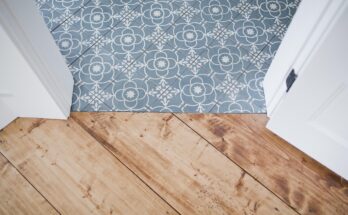ZonaJakarta – When it comes to making a room feel bigger, most people immediately think of wall colors, mirrors, or lighting tricks. But here’s something most people forget: the floor under your feet plays a huge role in how tall a space feels—especially if you’re working with low ceilings.
In small apartments, older homes, or cozy basements, a low ceiling can make a room feel boxed in or compressed. But with the right flooring, you can visually “lift” the room and create the illusion of height and openness—no expensive renovations required.
So if you’re standing in a short-ceiling space wondering how to open it up, here’s your guide to choosing the best flooring styles, colors, and finishes that make every inch count.
1. Go Light and Natural with Color
Let’s start with the most noticeable detail—color. In rooms with low ceilings, lighter-toned flooring is your best friend. Think pale oak, soft ash, light maple, or even whitewashed finishes. These shades help reflect light throughout the room and make the space feel brighter and more expansive.
Dark floors, while beautiful, can sometimes feel heavy—especially if the ceiling is already closing in from above. That doesn’t mean you have to avoid them entirely, but in tighter vertical spaces, a lighter floor gives you a visual “lift” from the ground up.
2. Choose Long, Continuous Planks or Patterns
Another key trick? Direction matters—a lot more than people realize. Using long, unbroken floorboards or tiles helps the eye move smoothly across the room, which enhances the feeling of space.
If possible, install flooring boards parallel to the longest wall or in the same direction as natural light—it stretches the room horizontally and draws the gaze outward. For bonus points, avoid busy patterns or heavily contrasting grout lines, which can visually “chop” the space and make it feel shorter.
Wide planks or large-format tiles can also help, as they create fewer breaks and more flow across the floor.
3. Stick to Low-Profile Flooring Materials
While most people think only about what color the floor is, the thickness of your flooring also matters—especially when ceiling height is already tight.
Skip bulky materials like thick carpets or raised wood panels. Instead, opt for thinner flooring types like engineered hardwood, luxury vinyl planks, or even polished concrete if you’re into a more industrial look. These materials keep your floor height low and your ceiling feeling just a little bit higher.
If you do want something soft underfoot, go for low-pile rugs or flat-weave options that add comfort without stealing vertical inches.
4. Embrace Reflective or Matte Finishes Strategically
Floor finish plays a subtle but important role in how light moves through the room. For example, in a space that’s lacking natural sunlight, a lightly polished or satin finish can help bounce light around, giving the illusion of a taller, brighter room.
That said, too much gloss can create glare and highlight imperfections—not ideal for tight spaces. A matte or satin finish is often the sweet spot: clean, modern, and easy on the eyes.
5. Coordinate with Walls and Trim for Visual Flow
Flooring doesn’t work in isolation—it has to play nicely with your walls and trim. In rooms with low ceilings, it’s smart to choose a flooring color that complements your wall paint, creating a seamless visual transition.
When the contrast between the floor and wall is too harsh, it can visually “split” the room. But when the tones flow together—even if they’re not exactly the same—the space feels more open and less broken up.
6. Avoid Busy Patterns or Overly Trendy Designs
We get it—bold patterned tiles, retro herringbone planks, and checkerboard floors are having a moment right now. But in low-ceilinged spaces, these styles can be risky. Busy or highly geometric patterns draw too much attention to the floor, pulling the focus downward instead of lifting it upward.
That doesn’t mean your floors need to be boring—just that in tight vertical spaces, simplicity and softness usually win. Think natural grains, smooth finishes, and a tone that blends into the room’s overall aesthetic.
7. Don’t Forget About Furniture and Rugs
Even with the perfect floor, cluttered layouts or oversized furniture can make your ceiling feel even lower. In small, low spaces, aim for furniture with clean lines and low profiles, and avoid thick, dark rugs that anchor the room too heavily.
Instead, use rugs as light accents—maybe a pale jute rug, a striped runner to draw the eye across, or something in a soft neutral that enhances the feeling of openness.
Final Thought: Flooring That Works With Your Ceiling, Not Against It
Designing for a room with a low ceiling isn’t about hiding the height—it’s about enhancing what you’ve got. And flooring is one of the smartest places to start.
The right floor color, finish, and layout can help your room feel taller, brighter, and more balanced—without touching a hammer or knocking out a single wall.
So if your ceiling’s staying where it is, your floor might just be the thing that lifts your whole space—and your mood—to new heights. (*)




